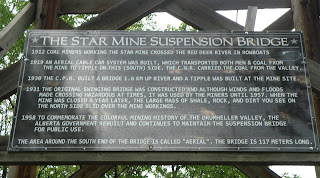After we left the Museum, we took the long way along the North Dinosaur Trail (Hwy 838) to get to Drumheller. We just needed to see one more Canyon and, of course, the Bleriot Cable Ferry that crossed the Red Deer River.
Bleriot Ferry: You would think that after spending seven
years taking the cable ferry back and forth to work at Little Narrows (Cape Breton), another cable ferry would be the last
thing we wanted to ride on. Not so. A little secret? I was really
looking forward to it.
“Nobody’s going
to take the ferry when there’s a bridge nearby,” explains Danis, (Gilles Danis of the Homestead Museum) “except if there is historical
significance, like the Bleriot Ferry.”
Because of the few
families in the area, the government of the day could not see their way to
construct bridges across the Red
Deer River so the
local people generally forded the river or crossed on rafts. The Munson Ferry
started running over a century ago and in 1955 was renamed the Bleriot
Ferry in honour of its first ferry Captain, Andre Bleriot.
Today 90% of the traffic is tourists but many of the locals still use the ferry to cross the river.
Today 90% of the traffic is tourists but many of the locals still use the ferry to cross the river.
Neither the Ferry
nor the channel is as big as Little Narrows but I enjoyed the crossing anyway.
The Horsethief Canyon
Legend has it that
thousands of horses belonging to various ranchers roamed freely in the Valley. They
would enter the canyon and would return carrying a different ranch brand . . . hence
the name Horsethief Canyon.
Other stories
claim that thieves once used the tucked-away area to hide stolen livestock.
There have been
over 35 dinosaur discoveries recorded in the region uncovering fossils dating
as far back as 70 million years ago. Today, even though it is off the beaten
track and not as popular, the Horsethief Canyon is an extension of the same formation as
the Horseshoe Canyon and offers very popular hiking trails.
We arrived at Drumheller on a Monday evening. “A Ghost Town in the making". Our motel was downtown and we assumed that it would be easy to find a place for supper within walking distance. You know that assumptions never work?
Right – there were no restaurants around that were open on Mondays! Really! Yup – we did walk to a place and were amazed to find more empty store fronts than there were businesses. Maybe we missed something!
When we got up the
next day, it was dull with on and off rain showers so we didn’t spend much time
wandering around the town.
Drumheller Valley was founded on the discovery of coal. Coal
mines dotted the Valley. Because coal is no longer a viable product, they have
turn many of the mining areas into historic tourist attractions.
The Star Mine was
one such place. They have reconstructed the Suspension Bridge that replaced the
row boats that took the miners to work across the Red Deer River.
We stopped by the Atlas Mine Site and were going to explore the hoodoos but the rain came belting down so we just stopped briefly to look at them.

Brooks Aqueduct
(Provincial and National) Historic Site
And how long have
we lived here in Southern
Alberta? We had
never heard of the Brooks Aqueduct before (and we had even lived in
Brooks for a couple of months). So this became the last stop on this leg of our
tour. We’re always curious to check out a place we had never heard of before.
Unfortunately, we discovered that the Aqueduct was not
open to the public on Tuesdays.
And what day were we there? Tuesday, of course.
BUT . . .
We wandered around
anyway. The CPR had constructed the Aqueduct in early
1900’s.
My first thought
was why would the CPR (Canadian Pacific Railway) construct an
aqueduct? When it came right down to it, the settlers needed water in order to
survive the dry parched area of Southern Alberta and the Railway needed settlers in order to sustain their
business.
Construction of
the Aqueduct started in 1912 and began delivering water by 1915. Three hundred
plus workers and 38 construction crews built 3-kilometres of an elevated trough
of 19,000 cubic meters of steel enforced concrete capable of delivering 70
cubic meters of water per second. It is most impressive.
The Aqueduct
remained functional until 1979.
This is one attraction
we will come back to!!






















